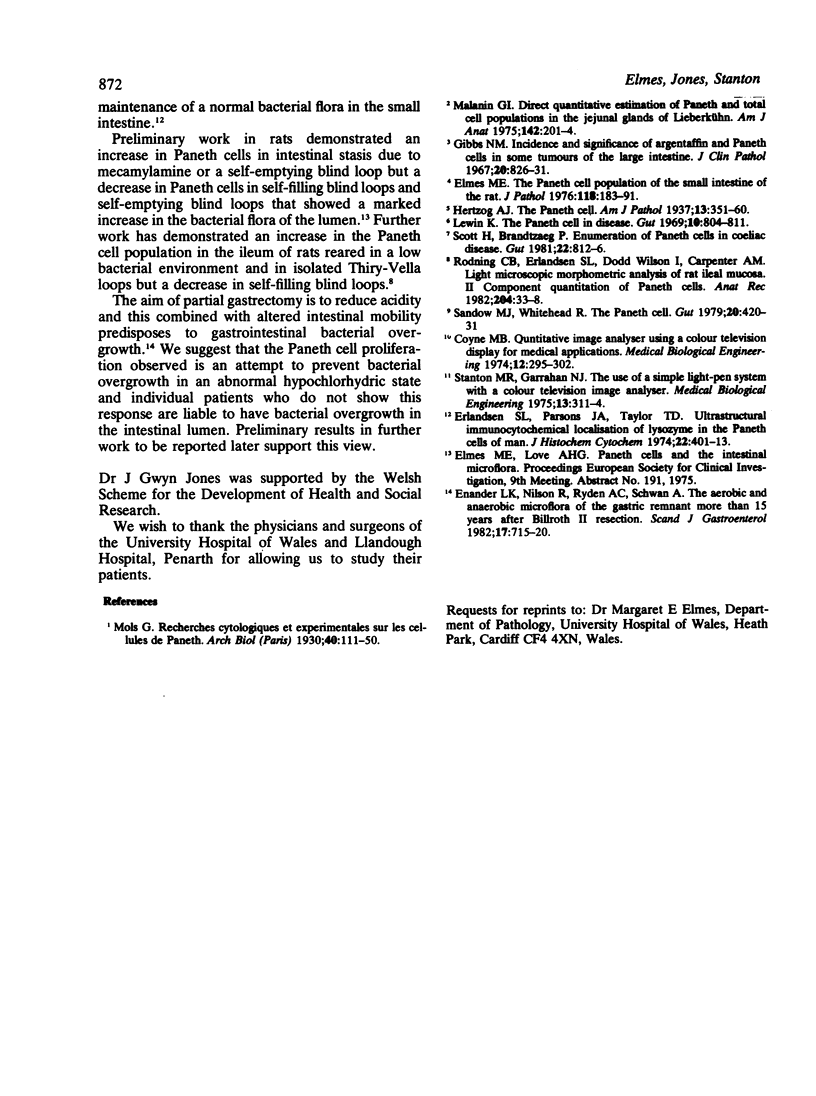Abstract
Estimates of the Paneth cell population in human jejunum and ileum were made using measurement of the granule area in micron2 by image analysis in a defined number of crypts. This figure was preferable to granule area per mm as there was a significant difference in crypts per mm between biopsies and surgical samples. In the jejunum no significant difference was found between normal children and adults with and without peptic ulcer. In adults with subtotal or partial villous atrophy the decrease in area was not statistically significant and there was no decrease in area in children with partial villous atrophy and coeliac disease. There was a marked increase in granule area in the jejunum of patients who had had a previous partial gastrectomy which was statistically significant. In the ileum patients with carcinoma of the caecum had higher values than patients with non-inflammatory non-malignant conditions but this was not statistically significant and two patients with Crohn's disease had an increased granule area. Paneth cell populations are affected by alterations in the intestinal luminal environment due to previous surgery or neoplastic or inflammatory disease.
Full text
PDF





Images in this article
Selected References
These references are in PubMed. This may not be the complete list of references from this article.
- Coyne M. B. Quantitative image analyser using a colour-television display for medical applications. Med Biol Eng. 1974 May;12(3):295–303. doi: 10.1007/BF02477794. [DOI] [PubMed] [Google Scholar]
- Enander L. K., Nilsson F., Rydén A. C., Schwan A. The aerobic and anaerobic microflora of the gastric remnant more than 15 years after Billroth II resection. Scand J Gastroenterol. 1982 Sep;17(6):715–720. doi: 10.3109/00365528209181084. [DOI] [PubMed] [Google Scholar]
- Erlandsen S. L., Parsons J. A., Taylor T. D. Ultrastructural immunocytochemical localization of lysozyme in the Paneth cells of man. J Histochem Cytochem. 1974 Jun;22(6):401–413. doi: 10.1177/22.6.401. [DOI] [PubMed] [Google Scholar]
- Gibbs N. M. Incidence and significance of argentaffin and paneth cells in some tumours of the large intestine. J Clin Pathol. 1967 Nov;20(6):826–831. doi: 10.1136/jcp.20.6.826. [DOI] [PMC free article] [PubMed] [Google Scholar]
- Hertzog A. J. The Paneth Cell. Am J Pathol. 1937 May;13(3):351–360.1. [PMC free article] [PubMed] [Google Scholar]
- Lewin K. The Paneth cell in disease. Gut. 1969 Oct;10(10):804–811. doi: 10.1136/gut.10.10.804. [DOI] [PMC free article] [PubMed] [Google Scholar]
- Malinin G. I. Direct quantitative estimation of Paneth and total cell populations in the jejunal glands of Lieberkühn. Am J Anat. 1975 Feb;142(2):201–204. doi: 10.1002/aja.1001420205. [DOI] [PubMed] [Google Scholar]
- Rodning C. B., Erlandsen S. L., Wilson I. D., Carpenter A. M. Light microscopic morphometric analysis of rat ileal mucosa: II. Component quantitation of Paneth cells. Anat Rec. 1982 Sep;204(1):33–38. doi: 10.1002/ar.1092040105. [DOI] [PubMed] [Google Scholar]
- Sandow M. J., Whitehead R. The Paneth cell. Gut. 1979 May;20(5):420–431. doi: 10.1136/gut.20.5.420. [DOI] [PMC free article] [PubMed] [Google Scholar]
- Scott H., Brandtzaeg P. Enumeration of Paneth cells in coeliac disease: comparison of conventional light microscopy and immunofluorescence staining for lysozyme. Gut. 1981 Oct;22(10):812–816. doi: 10.1136/gut.22.10.812. [DOI] [PMC free article] [PubMed] [Google Scholar]
- Stanton M. R., Garrahan N. J. The use of a simple light-pen system with a colour-television image analyser. Med Biol Eng. 1975 Mar;13(2):311–314. doi: 10.1007/BF02477748. [DOI] [PubMed] [Google Scholar]




